 By Kirye
By Kirye
and Pierre Gosselin
This is how alarmists operate today: Find one single extreme weather event and immediately behold it as proof of an impending climate change catastrophe. Never mind such events have happened earlier when CO2 was much lower.
“Record” heat at Verhojansk
Earlier this week, for example, teenage activist Greta Thunberg tweeted over at the now highly censored Twitter of a record warm reading recorded in Verhojansk, Siberia.
Verhojansk north of the Arctic Circle in Siberia recorded +38°C today… https://t.co/qla2lfvxeh
— Greta Thunberg (@GretaThunberg) June 20, 2020
Siberia has continental climate, temps range from -70°C to +40°C
What is supposed to be alarming about the reading is that it was recorded at the Arctic circle, which currently runs at 66°33′48.1″ north of the Equator. It’s supposed to be icy up there, with polar bears, so many people believe.
But that is of course not the case in the summertime. Hot temperature near 40°C near the Arctic circle have happened time and again in the past. The new record recorded at Verhojansk still needs to be confirmed by the World Meteorological Organization (WMO), and if it stands, it will break the old record set back on July 25, 1988, when the town hit 37.3°C. But this is nothing unusual because records get broken all the time.
Arctic circle heat not uncommon in the summertime
High temperatures up in the Arctic occurred also much earlier in the past. For example meteorologist Chris Martz tweeted how 105 years ago Anchorage and Fort Yukon climbed to 100°F (37.8°C).
On June 20, 1915, Anchorage, Alaska (Merrill Field) hit 100°, which set the state's hottest temperature on record. Seven days later, Fort Yukon also hit 100° which is the hottest temperature ever recorded within the Arctic Circle.
— Chris Martz (@ChrisMartzWX) June 21, 2020
100°F for one week in 1957
Reader Don Penim then added how the Chicago Tribune reported on July 14, 1957, that the temperature at Vorkuta, Russia, “inside the Arctic circle”, reached 100°F for en entire week!
What about 100 degree temperatures "EVERY DAY FOR A WEEK" inside the Arctic circle?
Chicago Tribune – July 14, 1957 pic.twitter.com/DXHUcsX7jf
— Don Penim (@Don_Penim) June 22, 2020
Siberia temperatures fell as CO2 rose
Next we look at NASA GHCN Version 3 and Version 4 mean annual temperature data for the weather station located at Verhojansk, Russia:
Data source: NASA GISS and here.
Note how the mean annual temperature trend fell 50 years long while CO2 emissions climbed. Clearly CO2 is not driving the temperature in Siberia, and many experts question the claimed large atmospheric warming effect that CO2 has on the globe.
Climate blogger Tony Heller also tweeted how the Arctic above 80° north is at normal temperature, and has not risen above normal in the summertime for 20 years!
https://twitter.com/Tony__Heller/status/1274992398033137665
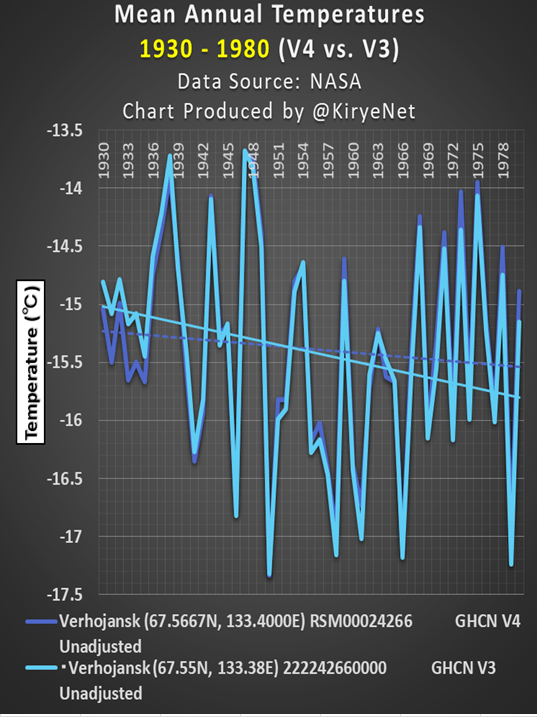
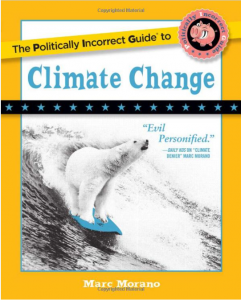
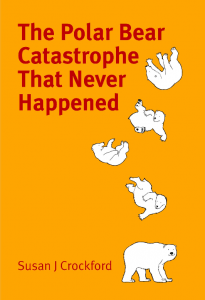
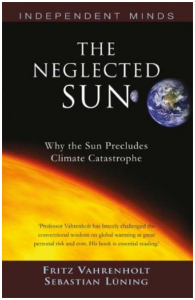
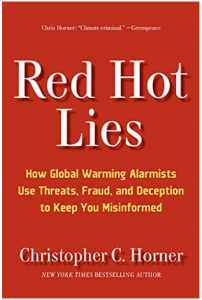

Where the Siberian heat wave was a fortnight ago, there is now anomalous cold and snow
https://www.gismeteo.ru/news/weather/snezhnoe-poholodanie-na-juge-sibiri-video/
My comment at Paul Homewood’s site:
Because the sub-solar point is far into the Northern Hemisphere during June, the day length is long. Solar insolation is therefore high. In fact it is higher from just south of 60° N. Lat. to the Pole than all other places on Earth.
See the chart here: insolation by Latitude
Verhojansk is a “continential” location – not near a coast. Such places are “air mass source regions.” We live in central Washington State and experience high summer temperatures and cold winters. Verhojansk is more extreme, but the physical aspects are similar.
Climate(s) – note the plural – are established by these sorts of geographic characteristics.
Many writers for publications such as this post quotes are clueless regarding how Earth works.
I am appalled that “Jonathan Bamber, Professor of Physical Geography, University of Bristol” would not know such stuff.
What did you do with the money, Jonathan?
“what money?”
The money your mother gave you for your education!
Why 1930-1980 ? Let’s see 1930-2020
After WWII, the use of fossil fuel increased, but the globe cooled.
I know, but I was curious to see the entire graph too.
https://twitter.com/KiryeNet/status/1275080054809047040
As reported by Roger at Iceagenow site says —
https://www.iceagenow.info/snow-cooling-in-southern-siberia-video/
“In the Krasnoyarsk Region, summer has been interrupted by a strong cold wave.
June 21 is snowing. Winter visited the Sayan pass on the border of Khakassia and Tuva. ”
This region is in Siberia — see https://en.wikipedia.org/wiki/Krasnoyarsk_Krai
I wonder if Kirye would care to comment on the “disturbing” 100degF recently recorded in western Siberia.
https://wattsupwiththat.com/2020/06/28/100-degrees-in-siberia-5-ways-the-extreme-arctic-heat-wave-follows-a-disturbing-pattern/